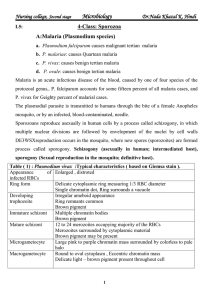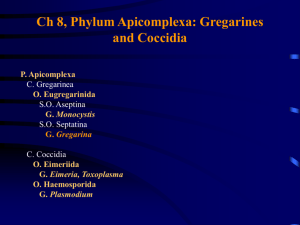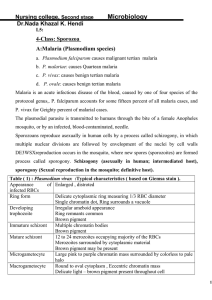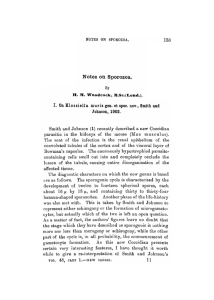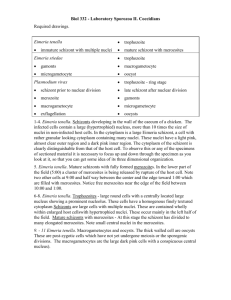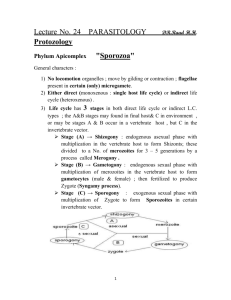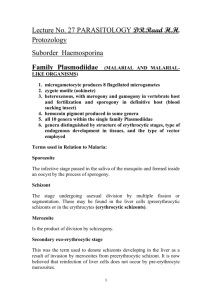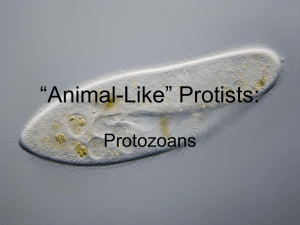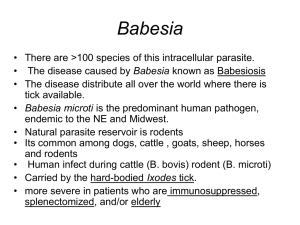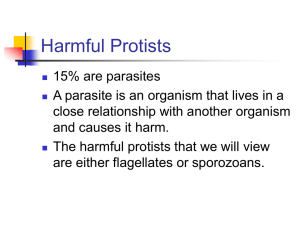Lab 3: Phylum Apicomplexa
advertisement
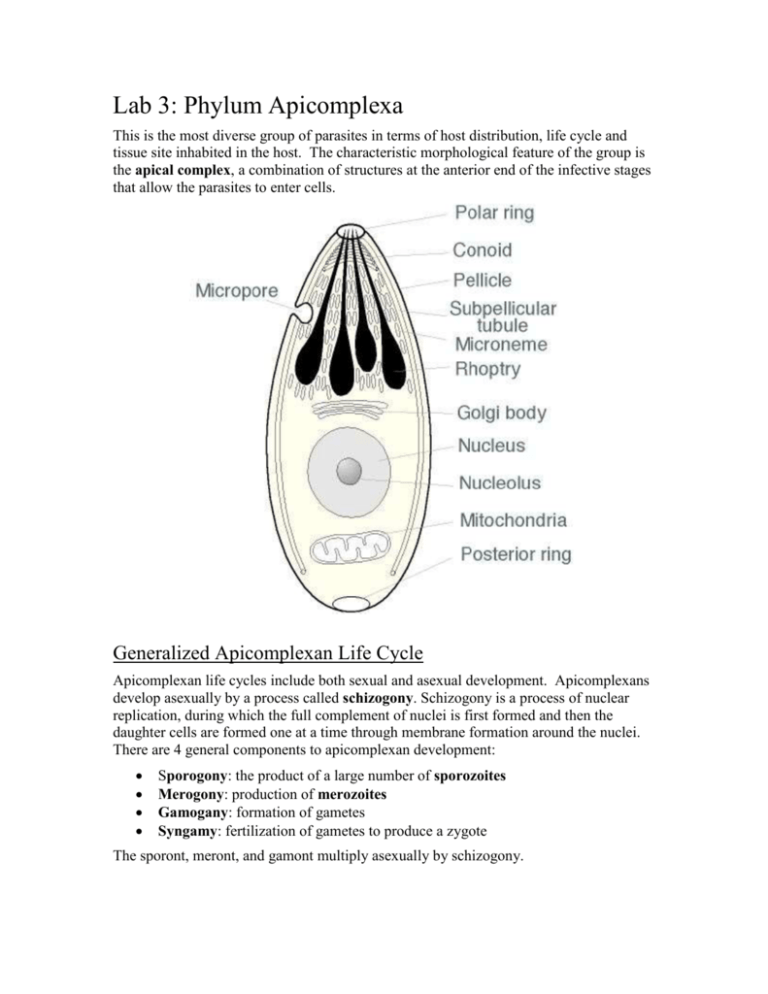
Lab 3: Phylum Apicomplexa This is the most diverse group of parasites in terms of host distribution, life cycle and tissue site inhabited in the host. The characteristic morphological feature of the group is the apical complex, a combination of structures at the anterior end of the infective stages that allow the parasites to enter cells. Generalized Apicomplexan Life Cycle Apicomplexan life cycles include both sexual and asexual development. Apicomplexans develop asexually by a process called schizogony. Schizogony is a process of nuclear replication, during which the full complement of nuclei is first formed and then the daughter cells are formed one at a time through membrane formation around the nuclei. There are 4 general components to apicomplexan development: Sporogony: the product of a large number of sporozoites Merogony: production of merozoites Gamogany: formation of gametes Syngamy: fertilization of gametes to produce a zygote The sporont, meront, and gamont multiply asexually by schizogony. The following is a generalized plan of the apicomplexan life cycle. Note that this is only a generalized plan. An understanding of the general plan will make the more specific plans associated with each of the different organisms much easier to understand. Differentiation Gamonts/ Gametes Micro gametocytes (male) Zygote SYNGAMY(sexual) -fertilization -fusion of gametocytes Macro gametocytes (female) GAMOGONY (more schizogony, asexual) Cyst/Oocyst SPOROGONY (asexual) Trophozoite/ Meront -intracellular Merozoite -break out and reinfect cells Zygote encysts MEROGONY / SCHIZOGONY asexual Schizont is a cell with schizogony going on inside it Once in host they excyst and differentiate intracellularly Sporozoites -Infective stage -Usually in Oocyst Infection typically involves a cyst or oocyst containing sporozoites, the infective stage in all apicomplexan life cycles. Sporozoites move through the host and invade host cells. Inside the cells the sporozoites develop into meronts or trophozoites. The trophozoites undergo merogony, a form of schizogony resulting in the production of merozoites. Merozoites then break out of the cell and re-infect new cells. In the new cell, they again transform into meronts /trophozoite, and initiate schizogony again. The second-generation meront/trophozoites may either go through more additional generations of merogony or it may differentiate into a gamont (gamogony). Gamonts develop into microgametocytes (male) or macrogametocytes (female). Fertilization of the gametes (syngamy) results in the production of a zygote. The zygote then develops a thick outer wall to become a cyst. In the cyst, the zygote undergoes meiosis, followed by a variable number of mitotic divisions (sporogony) to produce sporozoites. The apicomplexan life cycle always occurs in the direction indicated in the diagram above. 2 Class Gregarina Slide: Monocystis parasitize the seminal vesicles of earthworms. There is no schizogonic phase in the life cycle; sporozoites form trophozoites in sperm mother cells in the earthworm; these grow and eventually associate as pairs in a common cyst and develop into gamonts (sygyny). Hundreds of zygotes are formed in this common cyst and these become thick-shelled oocyts, each containing 8 sporozoites. These are released when the worm dies or via the genital pore. Class Coccidia: Order Eimeriida Species: Eimeria stiedae is a parasite of rabbits. Parasite development occurs in the bile ducts of the liver. The life cycle is direct and transmission occurs when the rabbit accidentally ingests food contaminated with oocysts, each containing 4 sporozoites. Once ingested, the sporozoites break out and travel to the bile duct and penetrate epithelial cells. Here they undergo schizogony forming a schizont that eventually forms many merozoites. Schizonts will rupture and release individual merozoites that go on to infect new epithelial cells. Some of these merozoites will undergo gamogomy and become microgametocytes or macrogametocytes. Microgametocytes will continue on to develop into microgametes. Microgametes will break out of the cells, penetrate cells containing macrogametes, and fertilize the macrogametes to produce a zygote. The zygote will then develop a thick wall and becomes an oocyst. Oocysts break free from the cells and pass through the digestive tract and out with the feces. 3 Slide: Liver tissue section infected with Eimeria stiedae. Study the liver section under low power to appreciate the architecture of the liver. Learn to distinguish the liver parenchyma from the bile ducts. Then focus in on the bile ducts and search for stages of the parasite. Trophozoites are round inclusions in the biliary epithelium. Macrogametocytes are large oval bodies with peripheral red-staining granules. Microgametocytes are few in number and more diffusely stained than macrogametocytes. Schizonts (contain merozoites) are more difficult to find. They contain 6-20 banana-shaped merozoites. Genus: Sarcocystis spp: There are a number of species of Sarcocystis, all of which have obligate two host life cycles. In most cases, an herbivore is the intermediate host, and many reptiles, birds and mammals serve as the definitive host. The life cycle is indirect generally involving a carnivore and herbivore host. The intermediate host (herbivore) is infected when it ingests oocysts that contaminate its food or water supply. The oocysts excyst in the small intestine releasing bradyzoites (akin to sporozoites), which move from the intestine to the circulatory system. The first generation of merogony occurs in the arteries in several organ systems of the body. The second-generation merogony takes place in small capillaries in the host tissues. Second generation merozoites then move through the circulatory system to striated muscle tissues where they eventually develop back into bradyzoites within mother cells called pseudocysts or sarcocysts. Carnivores (definitive host) then become infected when they ingest the flesh of an infected prey. In the definitive host the parasite infects the epithelium of the small intestine, reproducing asexually, eventually forming oocysts that are passed in the feces. 4 Slide: Sarcocystis tissue section. This image shows a cross section of a tongue showing three sarcocysts. Genus: Toxoplasma Toxoplasma gondii has very low host specificity, and will infect almost any mammal, and most nucleated cell types within a given tissue. Felines are the only known definitive hosts for Toxoplasma gondii. The Toxoplasma life cycle includes two phases called the intestinal (or enteroepithelial) and extraintestinal phases. The intestinal phase occurs in cats only (wild as well as domesticated cats) and produces oocysts. The extraintestinal phase occurs in all infected animals (including cats) and produces tachyzoites and, eventually, bradyzoites or zoitocysts. The disease toxoplasmosis can be transmitted by ingestion of oocysts (in cat feces) or bradyzoites (in raw or undercooked meat) In most humans infected with Toxoplasma, the disease is asymptomatic. However, under some conditions, toxoplasmosis can cause serious pathology, including hepatitis, pneumonia, blindness, and severe neurological disorders. This is especially true in individuals whose immune systems are compromised (e.g., AIDS patients). Toxoplasmosis can also be transmitted transplacentally resulting in a spontaneous abortion, a stillborn, or a child that is severely handicapped mentally and/or physically. 5 Slide: Toxoplasma smear: The following slide contains both intra- and extra-cellular tachyzoites. Although this is typically an intracellular stage, the cells containing the tachyzoites were broken open when the slide was prepared. Order Haemospora: Genus: Plasmodium This group includes the most pathogenic parasites of man. The word malaria literally means “bad air” reflecting the ancient belief that the disease was contracted by breathing bad air (swamp gas). Human malaria parasites belong to one of four species; Plasmodium vivax, P. falicparum, P. malariae, P. ovale. You do not have to learn to distinguish these species based on the blood smear! Be aware, however, that this can be done and know the sort of characters that are used! You should also become familiar with the epidemiology of each of the human Plasmodiums. Life cycles: Transmission to humans occurs when infected mosquitoes take a blood meal. Sporozoites in the salivary glands of the vector are introduced into the vertebrate host during feeding. Sporozoites remain in the blood for 30 minutes. These travel via the lymphatics and blood system to the liver where they enter a liver cell, transform into meronts, and undergo a series of schizogonic cycles (this cycle is called the exoerythrocytic phase, or EE phase). Eight days after sporozoite infection, merozoites derived from the EE cycle begin circulating in red blood cells (RBCs). The merozoites in the RBCs undergo another series of schizogonic cycles (this phase is called the erythrocytic phase). Inside RBCs, merozoites “round-up” to form the well-known “ring-form” meront (or ring-form trophozoite). Each meront will divide to produce 12-18 “daughter” merozoites. Schizogonic cycles eventually become synchronized so that the release of merozoites resulting from the bursting of red blood cells occurs at regular intervals (every 48 hours) causing a recurrent succession of fever and chills. Eventually, merozoites enter new RBCs, forming trophozoites that develop into microand macrogametocytes. These must be picked up by the vector to continue development. In the vector, the microgametocyte exflagellates, and the macrogametocyte is fertilized, developing into a motile zygote, the ookinete. The ookinete penetrates into the stomach of the vector and develops into an oocyst in which thousands of sporozoites develop. These travel to the salivary glands where they await transmission to the next host. 6 7 Be able to identify the different stages of Plasmodium. Keep in mind the types of slides (particular preparation) you are examining and where in the life cycle the parasite is likely to be when inside these tissues. Slide: Blood smear of Plasmodium vivax: Plasmodium vivax can be recognized by its variable ring stage. Schizonts contain about 16 merozoites and the infected cell is enlarged and contains Schuffner’s dots. The disease caused by this Plasmodium is mild and known as benign tertian malaria (fever paroxysms typically every 48 hours). Schizont Schizont with Schuffer’s Dots Ring stage 8 Slide: Blood smear of Plasmodium falciparum: has a very neat ring stage trophozoite. Multiply infected cells are common. Schizonts are rare in the peripheral blood. Gametocytes are crescent shaped. The disease caused by this organism is severe and known as malignant tertian malaria (fever paroxysms every 48 hours). It is this species that kills the vast majority of humans that die of malaria. Ring stage Schizont Macrogametocyte Slide: Human malaria in liver tissue: Hemozoin (digested hemoglobin) deposited in the cells of the spleen in a human infected with malaria. Slide: Human malaria sporozoite. 9 Genus: Haemoproteus are parasites of birds whose life cycles are similar to that of Plasmodium except that the asexual stages do not appear in the circulating blood cells, they remain in the tissues. The gamonts remain in the erythrocytes. Haemoproteus sp. has a two obligate host life cycle with the intermediate hosts being birds, generally pigeons or other columbiform birds and the definitive hosts being Hippoboscid flies and Culicoides. Birds become infected when bitten by Hippoboscid or Culicoides flies. Sporozoites enter the blood and invade the endothelial cells of blood vessels, lungs, liver, and spleen to form schizonts. The schizonts then undergo multiple fission and form cytomeres. Cytomeres grow within the endothelial cells while their nucleus divides. When the endothelial cells breakdown, they release multinucleate cytomeres, which accumulate in capillaries and release merozoites. Merozoites enter erythrocytes (red blood cells) and become microgamonts and/or macrogametes. Insects ingest the microgamonts and macrogametes with their blood meal. In the stomach of the insect, the gamonts fertilize and form ookinetes (zygotes). The ookinetes then crawl to the midgut wall and form oocysts. The oocysts mature and produce sporozoites, which break into the body cavity and pass to the salivary glands to be injected into a new host. Slide: Haemoproteus columbiae gametocytes. This preparation is a blood smear collected from birds. Note that bird erythrocytesare nucleated. You will find Haemoproteus gametocytes in the cytoplasm of the red blood cells. Genus: Haemogregarina These are parasites of the blood of frogs, lizards and turtles, and are transmitted by leeches or mites. Related species occur in fish. Slide: Haemogregarine gametocytes in frog blood. 10 11 12 Learning Objectives 1. Phylum Apicomplexa - General characteristics - Apical complex!! - 4 general components of Apicomplexan development 2. Class Gregarina – Monocystis spp. - Visual Id – common cysts, oocysts, sporozoite - Trophozoite stages feeding on sperm - There is no schizogonic phase - Host + tissue infected 3. Class Coccidia – Eimeria stiedae - Host, tissues infected, transmission - Life cycle - Visual id trophozoite, macrogametocyte, microgametocyte, liver/bile ducts 4. Class Coccidia – Genus Sarcocystis - Host, tissues, life cycle, transmission - Visual id 5. Class Coccidia – Genus Toxoplasma - Life cycle, transmission, hosts, tissues infected - Intestinal vs. extraintestinal phase (where they occur, in what species…) - Pathogenecity - Visual id – tachyzoites 6. Class Haemosporidia – Genus Plasmodium - Life cycle – what is definitive host - Transmission, - Visual id different stages and how they fit in life cycle - Pathology vivax and falciparum - Hemozoin in liver tissue 7. Genus Haemoproteus - Visual id gametocytes - Life cycle, host , transmission, etc. 8. Genus Haemogregarina - Visual id, host, transmission 13 Vocabulary Apical complex Schizogony Syngamy Sporogony Merogony Gamogony Oocyst Sporozoite Meront/Trophozoite Merozoite Microgametocyte Macrogametocyte Zygote Bradyzoite Sarcocyst Tachyzoite 14 Exoerythrocytic cycle Erythrocytic cycle Sporogonic cycle Ring-form trophozoite Ookinete Schuffner’s dots Hemozoin
